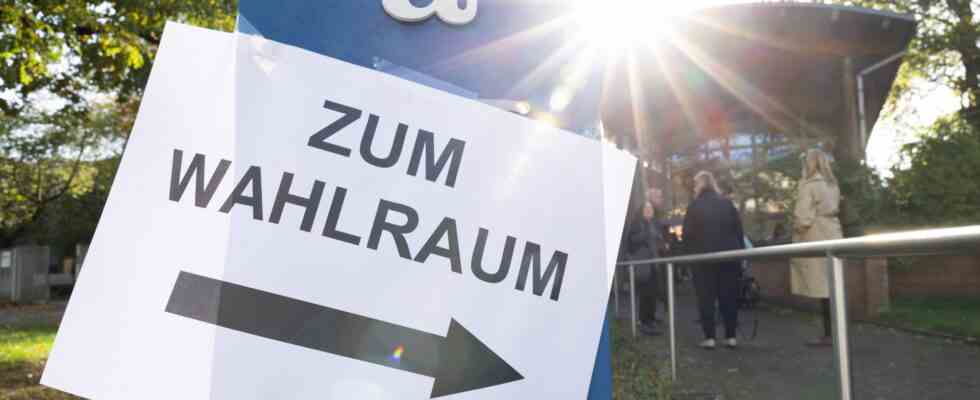analysis
Status: 09.10.2022 1:59 p.m
Good poll numbers for the prime minister and his government: actually the best prospects for the SPD in Lower Saxony. But in the current crisis, federal political issues dominate these state elections.
This state election is taking place in a situation that is unique since the founding of the Federal Republic. The majority of the population fears a loss of prosperity and their security. Since the start of ARD Germany Trends nearly 25 years ago, concern was never greater.
Last week, 85 percent of those surveyed nationwide stated that the conditions in Germany were cause for concern for them, only eleven percent were optimistic. Even if the economic situation in Lower Saxony is traditionally rated better and politics is rated more leniently than the national average, 75 percent are concerned here too. That will shape the voting decision.
Country issues in the background
The elections are taking place at a time when the escalation of the Ukraine war, the possible lack of gas and electricity in winter, inflation and an impending deep recession are much more conscious than at the state elections in spring.
State political issues take a backseat to the motives for personal voting decisions in Lower Saxony. The most important reasons for the decision are a secure energy supply, support in the face of price increases and climate protection. Only then does the education policy, which is controversial in Lower Saxony, follow, but which is decisive for only one in eight respondents.
people instead of programs
Many voters are aware that the major problems cannot simply be solved by political decisions in Berlin, let alone in Hanover. In such a situation, parties and programs recede into the background. The population looks even more closely than usual to the political personnel, looking for an anchor of trust, a person who is trusted to lead in a crisis.
When it comes to the SPD, which has been in power in Lower Saxony since 2013, the respondents see both light and shadow in equal measure. Prime Minister Stephan Weil is considered to be stable, calm and not very polarizing. His work is rated a little better than five years ago, but above all significantly better than that of his challenger Bernd Althusmann from the CDU and all leading members of the federal government.
67 percent of those eligible to vote consider Weil a good prime minister, as do supporters of the CDU, Greens and FDP with a clear majority. Although he does not reach the top values of his colleagues Daniel Günther in Schleswig-Holstein (78 percent) and Winfried Kretschmann in Baden-Württemberg (77 percent) before their last election, he still achieves good values in a country comparison.
Dissatisfaction with Scholz
On the other hand, the dissatisfaction with the federal government’s crisis management is clearly pronounced, which is mainly linked to SPD Chancellor Olaf Scholz. Only 43 percent of Lower Saxony are satisfied with his work, for 67 percent he seems hesitant and undecided, even half of the SPD voters rate it that way.
The fact that the SPD in Lower Saxony fell short of its last election result of almost 37 percent in the pre-election polls, although a majority is satisfied with the SPD-led state government, has to do with dissatisfaction with the federal government.
It is unclear whether confidence in Weil is so strong that he can still convince previously hesitant voters in the final sprint. Most recently in North Rhine-Westphalia, the SPD had serious mobilization problems in its strongholds, albeit with a little-known candidate and from the role of the opposition.
Greens hope for a record, FDP must fear
Despite all the criticism of the gas levy and other energy policy decisions, the Green Economics Minister Robert Habeck and, above all, the Green Foreign Minister Annalena Baerbock are better off than Chancellor Scholz and Finance Minister Christian Lindner from the FDP.
The Greens have a good chance of a record result in Lower Saxony. However, the regular electorate is apparently not satisfied with the crisis policy of the third traffic light partner, the FDP. After 20 straight years in the Lower Saxony parliament, she must seriously fear that she will return.
AfD benefits from protest mood
One of the signs of the crisis is a stronger mood of protest, from which the AfD is clearly benefiting. In addition to her core issue of immigration, the main motive for her voters, as at the height of the refugee crisis, is the rejection of the other parties. 90 percent of those surveyed who want to vote for the AfD also justify this by saying that the AfD is the only party “with which I can express my protest against the prevailing politics”.
Whether this protest focuses primarily on rising prices, sanctions against Putin, refugees or the Corona rules plays a minor role. A part of the electorate, who recently refrained from voting, can be mobilized again in the crisis and meet at the AfD.
Lower Saxony politically particularly stable
Despite all the symptoms of the crisis, Lower Saxony is almost a haven of political stability. It is one of the federal states in which the old West German party system with two people’s parties as strong pillars has largely been preserved.
The SPD and CDU tied 70 percent or more of the electorate here in the past elections. Both have their strongholds here, and in the 2021 federal election they achieved their best nationwide constituency results in Lower Saxony. The CDU was stronger in Cloppenburg-Vechta in the deeply Catholic Lower Saxon part of the diocese of Münster than anywhere else in the republic, the SPD in Aurich-Emden on the North Sea coast.
The political map in Lower Saxony will also be characterized by “red” and “black” regions on the day of the state elections. Who wins and how far ahead this party will ultimately depend on which party and which person the voters put more trust in the deepest crisis of the post-war period.

